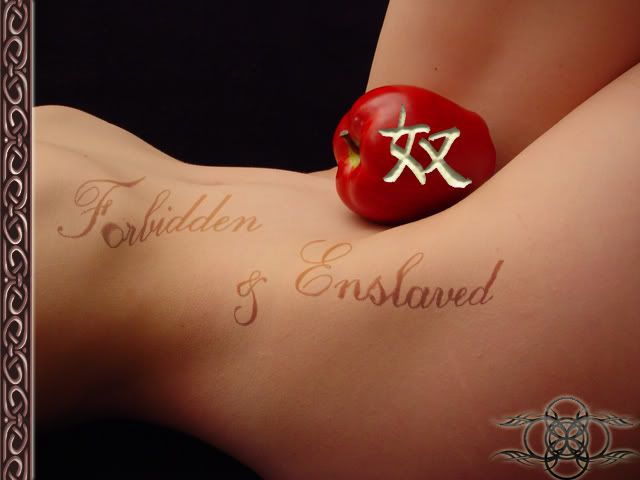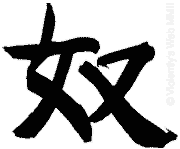It was ANZAC day on Monday, and for the first time I took Nicole to the civic rememberance service. She wore my grandfather's war medals. He was an English soldier during the Second World War. Nicole asked what the medals were for and I couldn't tell her. These are what he has...
The 1939-1945 StarThe 1939 - 1945 Star was to reward service in the Second World War between the dates of 3 September 1939 and 8 May 1945 (Europe) or 2 September 1945 (Pacific). Army and Navy personnel had the general qualification of six months in an operational area. The merchant navy had the same period of service, but with the requirement that a minimum of one voyage had been made through an operational area. The RAF aircrews had to complete two months' service in an operational area and to have been involved in flying operations against the enemy. RAF ground forces had to complete the six-month qualification period in an operational Army command. Service that was terminated by death or disability due to service, rendered the recipient eligible for the award of the Star. An award of a decoration, Mention in Dispatches or a King's Commendation also qualified the recipient for the award of the Star. The ribbon comprises three equal stripes of dark blue, red and light blue, to represent the Navy, Army and Air Force.
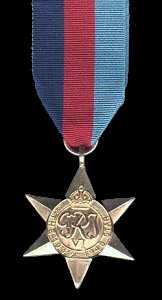
The 1939-1945 Star
 The Africa Star
The Africa StarThe Africa Star was to reward those forces involved in North Africa, Abyssinia, Eritrea, Malta and Somaliland, the qualifying period being from 10 June 1940 to 12 May 1943, the latter being the day before the last enemy troops surrendered in Africa. It recognizes Wavell's brilliant campaigns which Churchill did not appreciate, relieving him of his command in November 1941. During his time as Commander in Chief in the Middle East from July 1939 to November 1941, the Italian l0th Army had advanced into Egypt on 13 September 1940 and in five days were sixty miles inside the border. Wavell's desert force, although outnumbered, began to drive them back on 9 December. The 6th Australian Division captured Benghazi on 6 February 1941 and the Allies controlled Cyrenaica.
During the month he launched a series of offensives against the Italians in East Africa which led to the surrender of Addis Abbaba by the Italians on 6 April. Wavell had to reinforce Greece when it was invaded, leaving only one infantry and one armoured division to protect Cyrenaica. The German 5th Light Division, the first part of what was to become the Afrika Korps, started to arrive in Libya on 14 February 1941. The second division of the Afrika Korps to arrive in Libya was the 15th Panzer Division in mid-April 1941, under the command of Feldmarschall Erwin Rommel, who was later to become known as the Desert Fox.
This brilliant general outmanoeuvred Wavell's ill-equipped force, a risk Wavell had perceived, and the Axis forces reached the Egyptian border on 11 April 1941. Thus the capture of Benghazi was to be the only Allied victory until the Battle of El Alamein on 23 October 1942. On the night of 23/24 October the attack opened with a barrage from 1,000 guns. During a week of bitter fighting, losses mounted until Montgomery decided to make his major push on 2 November at Kidney Ridge. In the ensuing tank battles the Germans were decisively defeated and on 5 November, Rommel ordered a full retreat. This gave rise to the final surrender on 13 May 1943 of all the Axis forces in Africa.
The Star was gained by the service of one day in an operational area. The prerequisite of the 1939-1945 Star was not necessary for the bestowal of this star. One of the three clasps could be added to the ribbon. These, however, differ from the others by virtue of the fact that they denote units as opposed to the award of another star and are self explanatory.
The ribbon comprises a sand-coloured 32 mm band, with a 9 mm central red stripe and a 2 mm dark blue stripe and a 2 mm light blue stripe on either side, flanking it by 5 mm. The colours represent the sand, red for the Army, dark blue the Navy and the light blue the Air Force.

The Africa Star
 The 8th Army Bar
The 8th Army BarThe 8th Army Clasp was awarded to members of the 8th Army serving between 23 October 1942 and 12 May 1943. A silver number '8' is worn on the ribbon to denote possession of the bar.
The France and Germany StarThe France & Germany Star was to reward service in France, Belgium, Holland and Germany. The prerequisite of having been awarded the 1939-1945 Star was not necessary to the rendering of this star, only one day of service between the qualifying dates of D-Day, and VE Day, 6 June 1944 to 8 May 1945 being necessary. The main intention of this Star was to reward some of the heaviest fighting of the whole war and as with the other stars (except the Italy Star), the first gained precluded the award of a similar star.
The ribbon is a 32 mm band made up of five equal stripes of blue, white, red, white and blue, the three colours being the national colours of Britain, France and Holland. Belgium, it seems, was excluded in remembrance in the emblematical use of the colours in this ribbon.
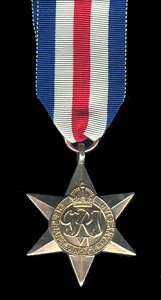
The France and Germany Star
 The Defense Medal
The Defense MedalThis medal was to reward those members of auxiliary services, such as the fire service, air raid precautions, police and ambulance services as well as military personnel. The qualifying period for the Medal was between the dates of 3 September 1939 and 2 September 1945. There was no pre-requirement for the award of the 1939-1945 Star and, in fact, The Defence Medal was harder to qualify for than some of the stars. It was necessary to have served for three years in the United Kingdom or six months overseas in territory subject to air attack. Service terminated by death or wounds due to enemy action was considered to render a person eligible. Those who had received a personal award conferred by the king were also eligible, irrespective of their length of service, provided they were serving in either category aforementioned. However, if a man or woman serving in the civil defence gained either the George Cross or the George Medal, the recipient automatically became eligible for The Defence Medal, irrespective of category or service.
The obverse consists of the coinage type head of George VI with, in small raised capital letters beneath the truncation of the head, the initials of the designer, 'HP' for T. Hugh Paget. Round the edge of the medal is the circumscription 'GEORGIVS VI D:G: BR:OMN:REX: F:D: IND: IMP'.
The reverse design comprises a small stylized oak tree set on to a slightly convex ground surmounting two lines of waves running from left to right. On either side of the oak tree are two rampant lions facing one another but with their heads looking in opposite directions and upwards in roaring stance. Right paws are in a position to guard the tree, while the left ones are extended guarding against air attack. Surmounting the tree is a crown and in the roots is the designer's monogram, 'HWP', for Wilson Parker. The lower part of the medal has the inscription in two lines, 'THE DEFENCE MEDAL', beneath which, on the lions' backs, at the medal's edge, are the dates 1939 and 1945. From the top of the medal there is a ball and straight bar suspender.
There are two versions of the medal. The first was issued to British Forces unnamed and produced in cupro-nickel. The Canadian version was issued named and produced in silver, in a grade of .800 fine.
The ribbon comprises a 32 mm band of green, with a central orange-red stripe 8 mm wide, with two black stripes 1.5 mm wide on either side, inset from the edge by 4 mm. The green emblematically represents the green grass of England, the red the fires caused by the bombing and the black, the blackout.
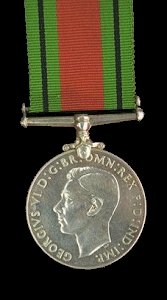
The Defence Medal
 The 1939-1945 War Medal
The 1939-1945 War MedalThe War Medal was to reward military service during the Second World War. The qualifying period was the same as that for The Defence Medal but it was only necessary to serve for 28 days in any of the armed forces, to gain entitlement. In the case of the merchant navy, the requirement was that the 28 days had to be served at sea. Provision was made for operational service terminated by death, wounds, disability or capture. In such cases, if the person had previously qualified for one of the campaign stars, the recipient was also entitled to the War Medal.
The obverse design comprises a crowned effigy of George VI with, at the truncation in small, raised capitals, the initials 'PM' of Percy Metcalfe the designer. The medal has the circumscription 'GEORGIVS VI D: G: BR: OMN: REX ET INDIAE IMP'.
The reverse design is most striking in its subject matter, being a dragon with two heads. The heads have beaks. Standing on the back of this crouching or fallen dragon is a lion facing to the right, with three paws on the creature's carcase and the front offside on its head. Just above this head, in small raised capitals are the initials of the designer, 'E CRP' for E. Carter Preston. In two lines at the top of the medal, and to the left of the ball of the suspender, are the dates 1939 over 1945. The suspender is of the straight bar variety.
Three types of the Medal can be encountered. The British forces award type which was produced in cupro-nickel and was issued unnamed. The Australian and South African award types which were also produced in cupro-nickel but awarded named. The Canadian award type which was produced in silver .800 fine. It was awarded named to approximately 700,000 eligible Canadians. When rendered to the next of kin as well as the Canadian Memorial Cross a silver Bar was added with the name and date of death attached to the ribbon.
No bars were awarded with this Medal but there was provision for the wearing of the Mentioned in Dispatches or a King's Commendation device on the ribbon. The ribbon comprised a 32 mm band that had five nearly equal stripes of red, blue, white, blue, red. The central white stripe contained an inner central stripe of red 2 mm wide.

The 1939-1945 War Medal
 Queen's Police Medal
Queen's Police Medal
For exemplary police service.
Dunkirk MedalAwarded to the veterans of the battle for Dunkirk in 1940
